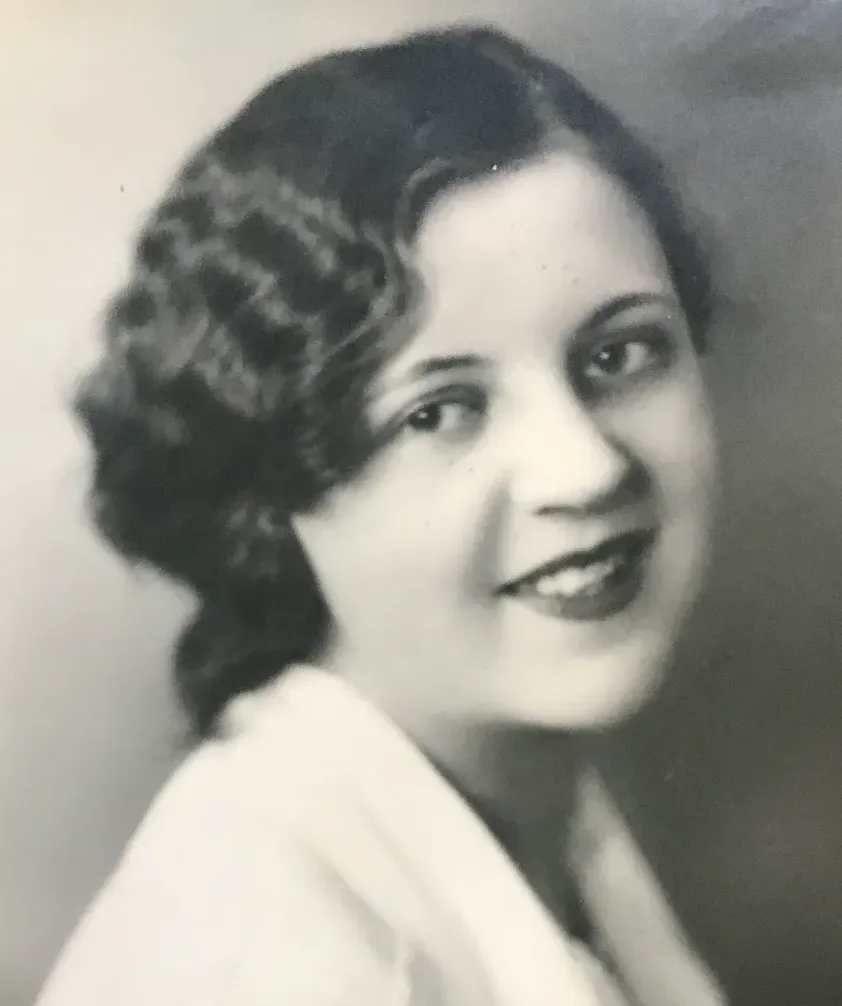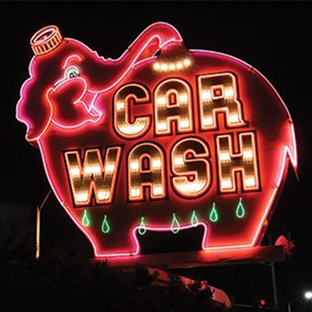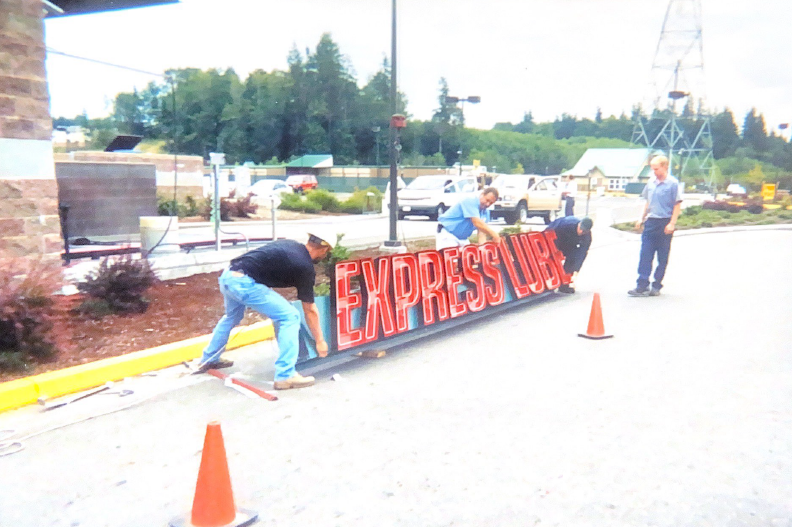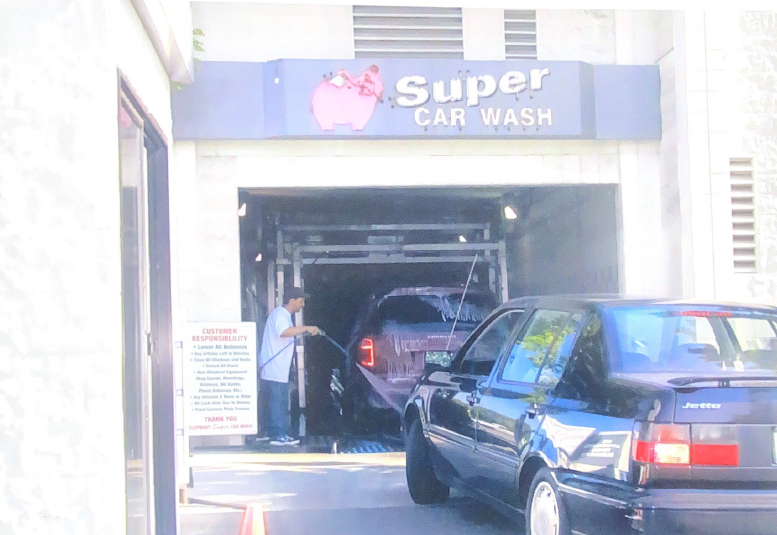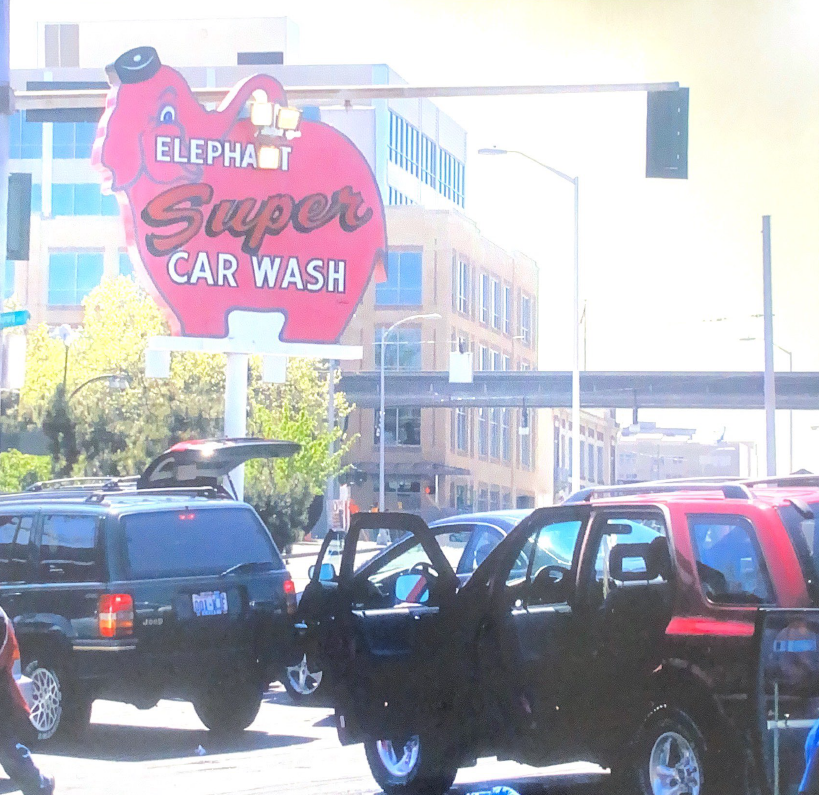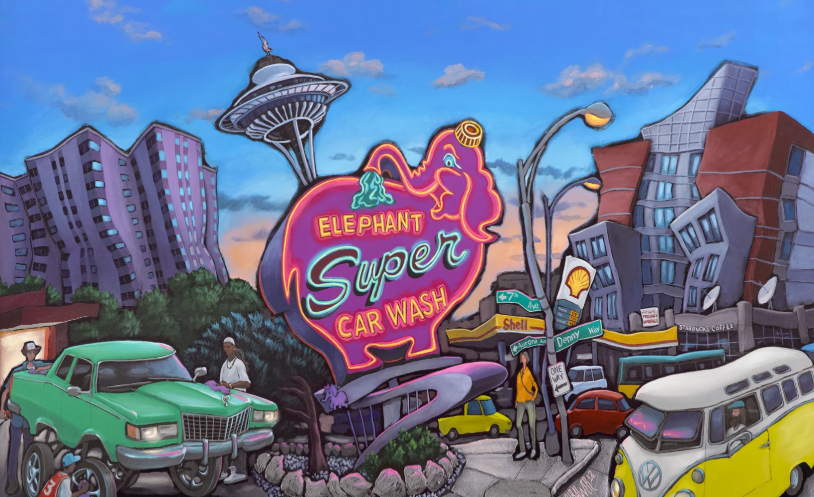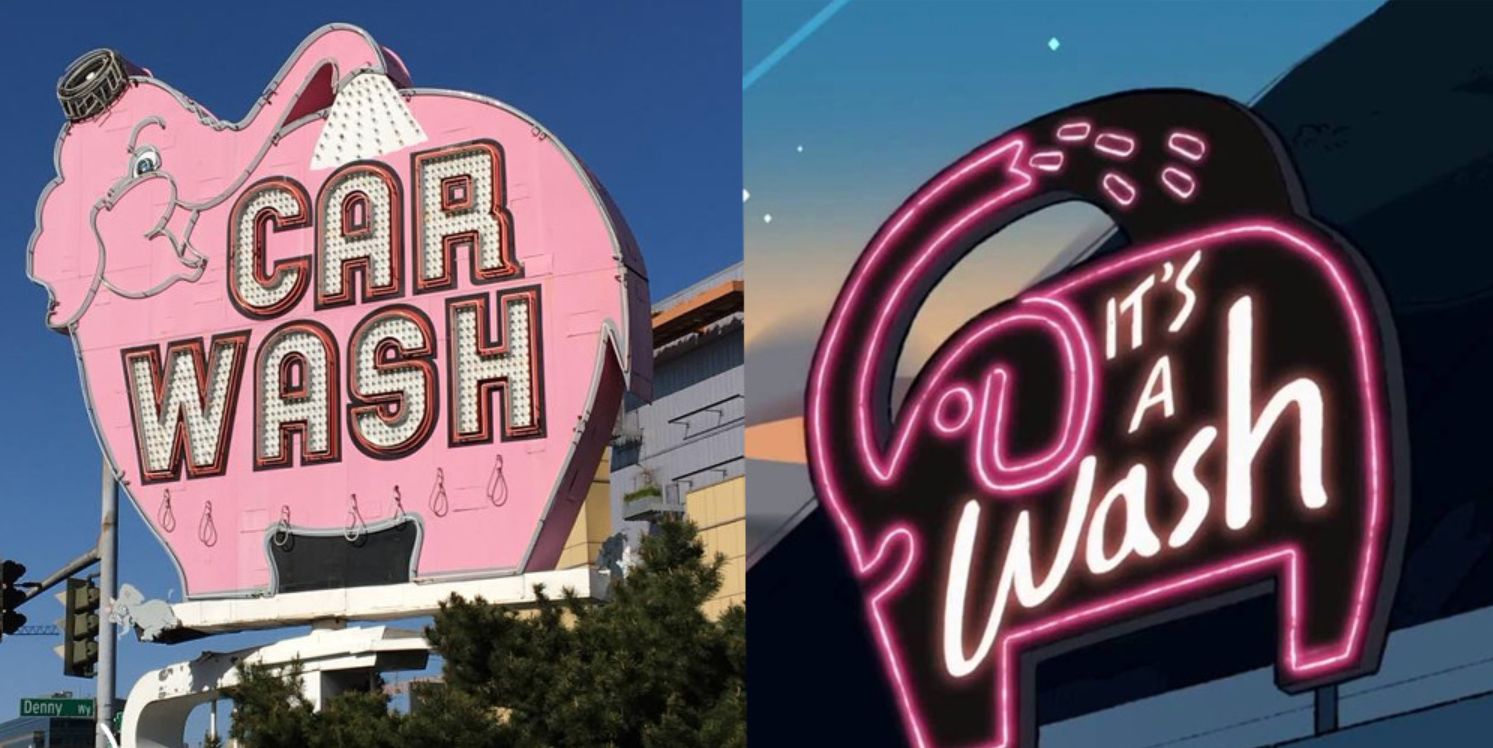Our History
A Timeline of Innovation & Iconic Seattle History
Wash Types & Equipment
Origins
Washing Cars
& Making History
The story of Elephant Car Wash doesn’t begin in a wash tunnel—it begins on a humble farm in Oak Harbor, Washington. In the early 20th century, Anker Morris Anderson and Emillie Katrina Christensen, both children of Scandinavian immigrants, married in Minnesota before heading west in search of opportunity. By 1912, they had settled in Oak Harbor, where they raised six children—five sons and one daughter—on a working family farm rooted in hard work and resilience.
Among those children were three brothers whose unique talents would shape an industry: Eldon Hadley Anderson, the mechanical genius and visionary inventor; Archie Wallace Harvey Anderson, the charismatic operator and public face of the business; and Densmore “Dean” Goodwin Anderson, the resourceful technician and steady hand who kept everything running behind the scenes.
Together, they would go on to revolutionize the car wash experience, launching a brand that became both a Seattle icon and a lasting family legacy—one that would continue to evolve and inspire the community and generations to come.
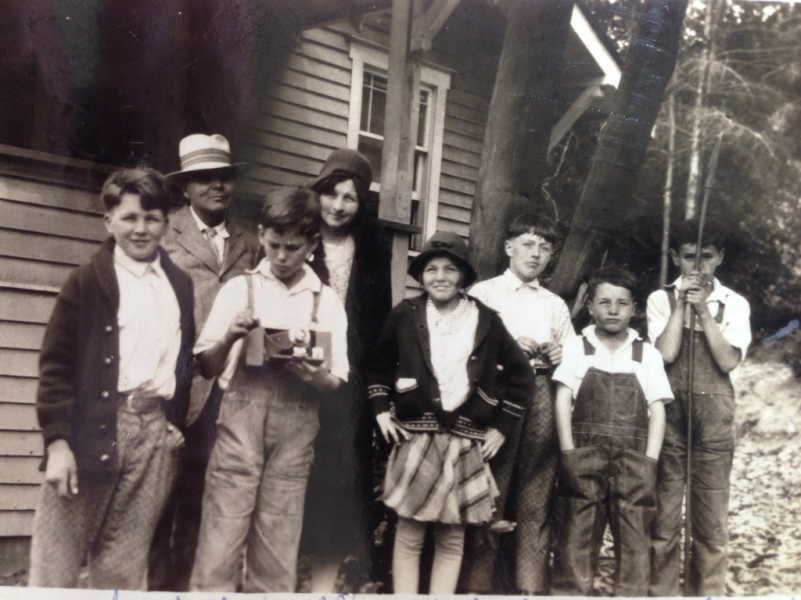
The Anderson kids (who would grow to open Elephant Car Wash) on a rare family vacation, dressed in their best, two decades after settling in Washington State. Portrait of the Anker M. Anderson family, circa 1930.

A portrait photo of the Anderson family. Front row left to right: Eldon, Emillie, Anker, Densmore (Dean). Back Row left to right: Arbutus, Milton, Archie, Delmon. 1940
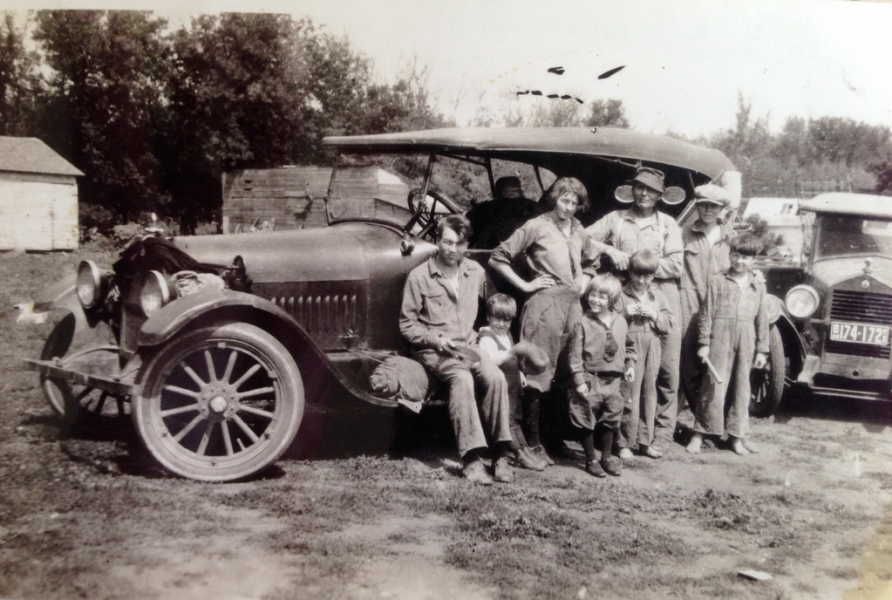
The Anderson kids
(who would grow to open Elephant Car Wash)
grew up around cars and farm machinery. Pictured: The Anker M. Anderson family with two vehicles—both occasionally used as tractors—on their Washington farm, circa 1926.
1950
From Farm Kids to
Car Wash Pioneers
By 1950, Eldon Anderson and his wife Virginia Ione (maiden name Moy) had begun to lay the groundwork for something revolutionary—an automatic car wash unlike anything that existed. Eldon, a mechanically gifted innovator, had spent years as a steam shovel operator working on major projects like the Deception Pass Bridge, before settling into a more stable life as a shop foreman at Boeing during World War II. Never one to sit still, Eldon earned his real estate license, invested in property, and built two homes from river rock with Virginia—stone by stone.
But his most ambitious project began to take shape with help from his brother Dean Anderson, a multi-talented problem-solver who split his time between family farming and invention. Together, they developed a groundbreaking system that would change the way cars were cleaned. Prior to their invention, car washes required attendants to manually scrub, soap, and dry vehicles as they were pulled along by simple pulley systems.
But they knew they could do it better...
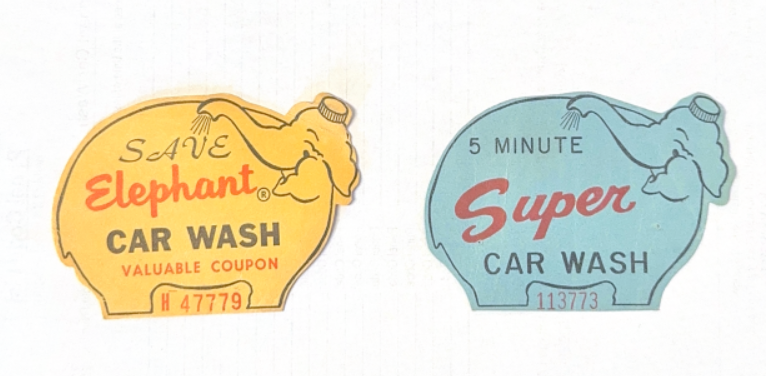
Before it was named Elephant, the wash operated as A.D. & E. Corp—sometimes known as the Five Minute Car Wash. Even then, their elephant-shaped coupons hinted at the iconic brand it would one day become.
1951
The FIRST
FULLY Automated Car Wash?
In 1951, the Anderson brothers' vision became reality when Eldon, Virginia, and Dean Anderson opened the Five Minute Car Wash at 4th Avenue South and Lander Street in Seattle. At the core of their operation was a truly groundbreaking innovation: a motorized car-pulley conveyor system paired with overhead sprinklers, automated soap and water nozzles, mechanized brushes, and a powerful 50-horsepower dryer. Unlike the Minit-Man system developed in Detroit by Leo Rousseau, Eldon and Dean built this system together, independently engineering what was quite possibly the first fully automated, hands-free car wash in the world—and undeniably the first of its kind in the state of Washington.
Their advanced tunnel design eliminated the need for manual scrubbing and rinsing, drastically improving efficiency and delivering a cleaner, safer, and more consistent wash. The concept was an immediate success, earning attention for its ingenuity and setting a new standard in car wash innovation.
1952
Building Wash
Equipment Into A Business
As demand grew, the Anderson family formalized their car equipment venture under the name A.D.& E. Corp., combining the initials of the three founding brothers: Archie, Dean, and Eldon Anderson. Each brought unique strengths to the enterprise. Eldon, the mechanical mastermind, designed and engineered the wash systems. Dean, the quiet technician, kept the operation running behind the scenes. And Archie, the charismatic operator, became the public face of the business—managing day-to-day operations, hopping into the tunnel during rushes, and ensuring each location ran smoothly. Together, the Anderson brothers built more than a business—they created a Puget Sound institution and laid the foundation for what would become one of the most recognized and beloved car wash brands in America.
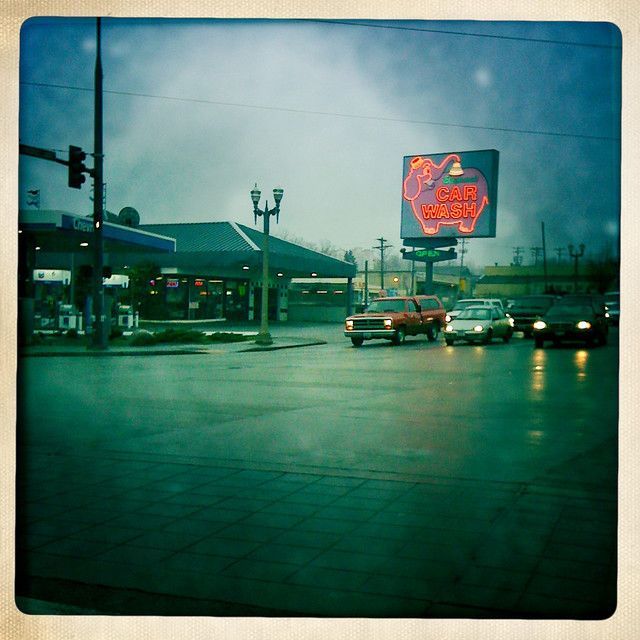
By the 1990s, the Pink Elephant location in Tacoma stood as a symbol of the Anderson brothers’ legacy. What began as A.D.& E. Corp—named for Archie, Dean, and Eldon—had grown into a Puget Sound institution. With Eldon’s engineering, Dean’s steady hand, and Archie’s showmanship, the brothers built more than just car washes—they built one of America’s most iconic brands.
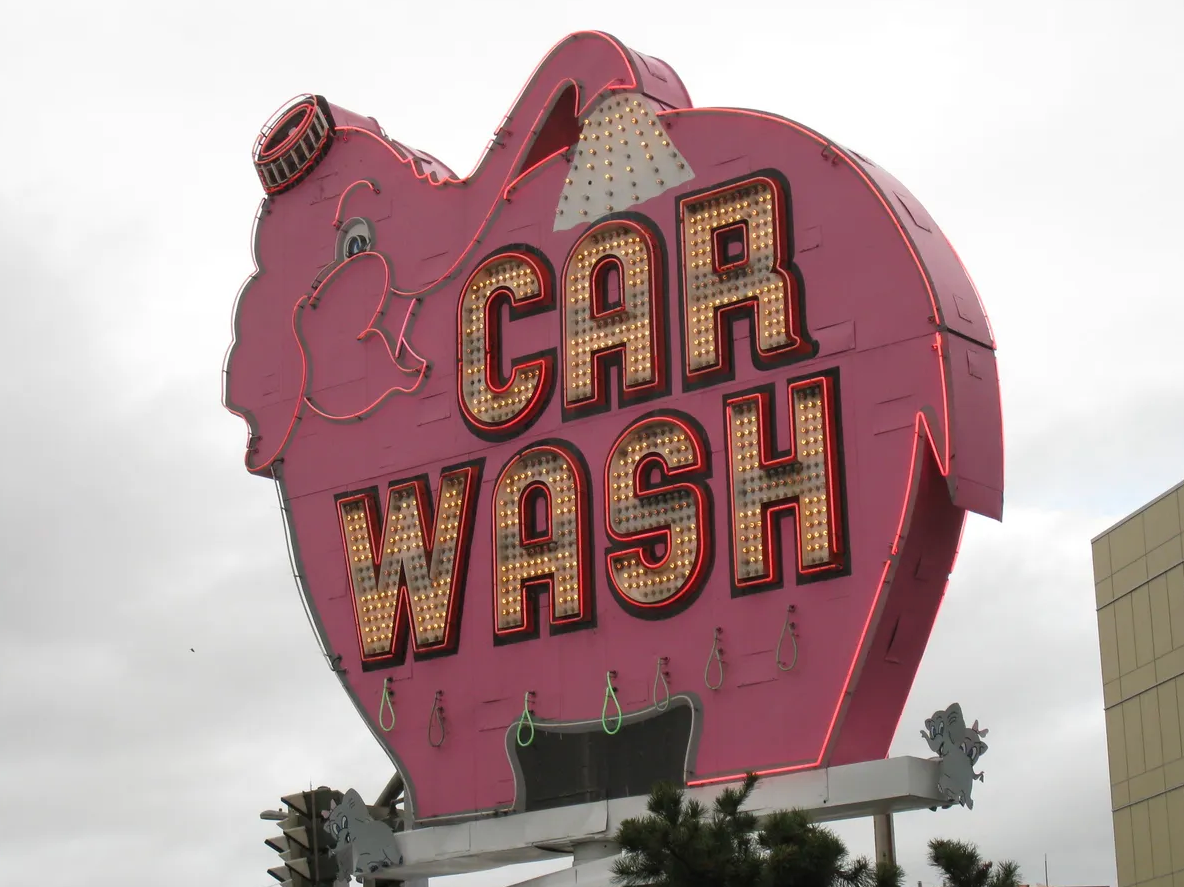
A close-up of the iconic rotating pink elephant—a playful twist that became legendary. Originally commissioned in 1956 for the flagship Denny Way wash, the sign was Archie Anderson’s bold vision brought to life. What started as a clever illustration on wash tickets became the face of a brand that redefined car wash marketing. With Archie’s flair and the Anderson brothers’ ingenuity, the Elephant Car Wash became a symbol of Seattle charm and American roadside culture.
1956
The Pink Elephant is Born!
By 1956, the Anderson brothers’ trailblazing car wash business officially welcomed its youngest partner—Archie Wallace Harvey Anderson (1916–2001). Though Archie had been working alongside his brothers Eldon and Dean for years, it wasn’t until this point that he became an official partner in the company. With Archie on board, the business not only expanded its footprint, it also gained a new identity—one that would reshape car wash marketing, design, and branding forever.
That same year, the brothers broke ground on their third location, strategically positioned just north of downtown Seattle at 6th Avenue and Denny Way. The site—a distinctively shaped triangular parcel just off Highway 99—sat in a busy commercial corridor that had yet to be intersected by Interstate 5, making it a prime location for visibility and high-volume traffic. Branded as the Elephant Super Car Wash, this flagship location featured cutting-edge equipment and newly patented innovations by Eldon, further solidifying the Andersons’ reputation as pioneers in automated car washing. But it wasn’t just the technology that made a splash—it was Archie’s imagination.
For years, Archie had been using an elephant illustration on the wash’s paper tickets, convinced that the animal—with its powerful, self-spraying trunk—was the perfect symbol for a clean, high-pressure wash. He eventually pitched the idea to rebrand the entire business around that image, and with the enthusiastic support of his brothers, the Elephant Car Wash name was officially born. Archie’s daughter, Lana Weed, later recalled that the origin story may have had another spark of inspiration—a little girl once called into a local radio show and suggested “Elephant Car Wash” as a name, a moment that stuck in Archie’s mind and helped seal the decision.
The now-famous rotating pink neon elephant sign at Denny Way (now preserved at MOHAI)—often mistaken as a meticulously designed brand icon—was actually a happy accident. When the Andersons commissioned the sign from Campbell Neon, the artist recommended pink neon as a playful twist. Archie agreed, and the result was an eye-catching, kinetic sculpture that would become one of Seattle’s most photographed landmarks. Lana also remembered that the color and glow weren’t planned—but they were perfect.
Archie didn’t stop at signage. He brought showmanship and humor to the business, creating stunts and promotions that made the brand larger than life. When the circus came to town, he’d run elephants through the wash tunnel, drawing curious crowds and media attention. Once, he even rigged an elephant onto pontoons to stage a whimsical shot of the animal “waterskiing.”
What began as a clever name became a powerful brand—one rooted in personality, family ingenuity, and unforgettable curb appeal. Thanks to Archie’s creative spark, the Elephant Car Wash became more than a service—it became a Seattle icon and a standout moment in the history of American roadside culture.
1. Bea Haverfield, Seattle’s “Queen of Neon,” brought color and character to the city’s skyline with her vibrant sign designs.
2. A close-up of the Elephant Super Car Wash sign reveals four playful baby elephants—each one a tribute to Bea’s four children.
3. A Seattle icon in glowing pink—Bea Haverfield’s Elephant Super Car Wash sign became her most beloved work. Designed in the 1950s, its towering elephant and four smaller babies weren’t just whimsical touches—they represented Bea’s own children, making the sign as personal as it was unforgettable day and night in the Seattle skyline.
1956
Bea Haverfield
The Woman Who Lit Up Seattle
In 1956, Beatrice “Bea” Haverfield—already a rising star in Seattle’s neon scene—was handed a project that would define not only her career, but the visual identity of an entire city. The Anderson brothers had just broken ground on their second Elephant Car Wash location at Battery Street and Denny Way and needed a sign that could match the boldness of their innovation. Archie Anderson pitched the idea of an elephant—quirky, powerful, and memorable. The team at Campbell Neon, Seattle’s top sign company, loved the concept and offered a playful twist: “What if the elephant was pink?”
The project was handed to Bea. And she didn’t just bring the idea to life—she elevated it into art.
Already known for her work on signs like Ivar’s Acres of Clams, Chubby & Tubby, Sunny Jim Peanut Butter, and Dick’s Drive-In, Bea was no stranger to designing for local businesses. But this job was personal. The massive rotating pink elephant she created was whimsical, fun, and completely unforgettable. Surrounding the central figure were 380 blinking neon lights and—at the base—four smaller elephants, lovingly added by Bea herself. Two wore pink bows, two wore blue—each one dedicated to her own children.
Seattle had never seen anything like it. Drivers came for the novelty, but the image stuck. In an era when pink elephants were icons of playful Americana, Bea captured the spirit of the time and gave it a local heartbeat. Her creation wasn’t just a sign, it was an experience—one that made people stop, smile, and pull in for a wash. The pink elephant became a landmark, appearing in movies, TV shows, postcards, and thousands of family vacation photos. It became so iconic that a competing car wash rebranded itself as Brown Bear Car Wash, hoping to capture even a fraction of the Elephant’s charm.
What set Bea’s work apart was more than just neon craftsmanship—it was storytelling. Her signs didn’t just advertise; they invited people into a world. In the case of Elephant Car Wash, she transformed a clever idea into a cultural touchstone, helping to build one of the most recognizable brands in Seattle and across the car wash industry.
As the pink elephant drew crowds and national attention, the Anderson brothers knew they had something extraordinary—and they weren’t done innovating. With Archie pushing the boundaries of branding and curb appeal, Eldon turned his attention to refining the technology itself. Behind the scenes, he began designing new features, filing patents, and improving wash performance—laying the groundwork for even more advanced equipment that would define the future of automatic car washing. The glow of Bea’s elephant sign marked more than just a business—it marked the beginning of a new era, where bold design met mechanical ingenuity and set the stage for what came next.
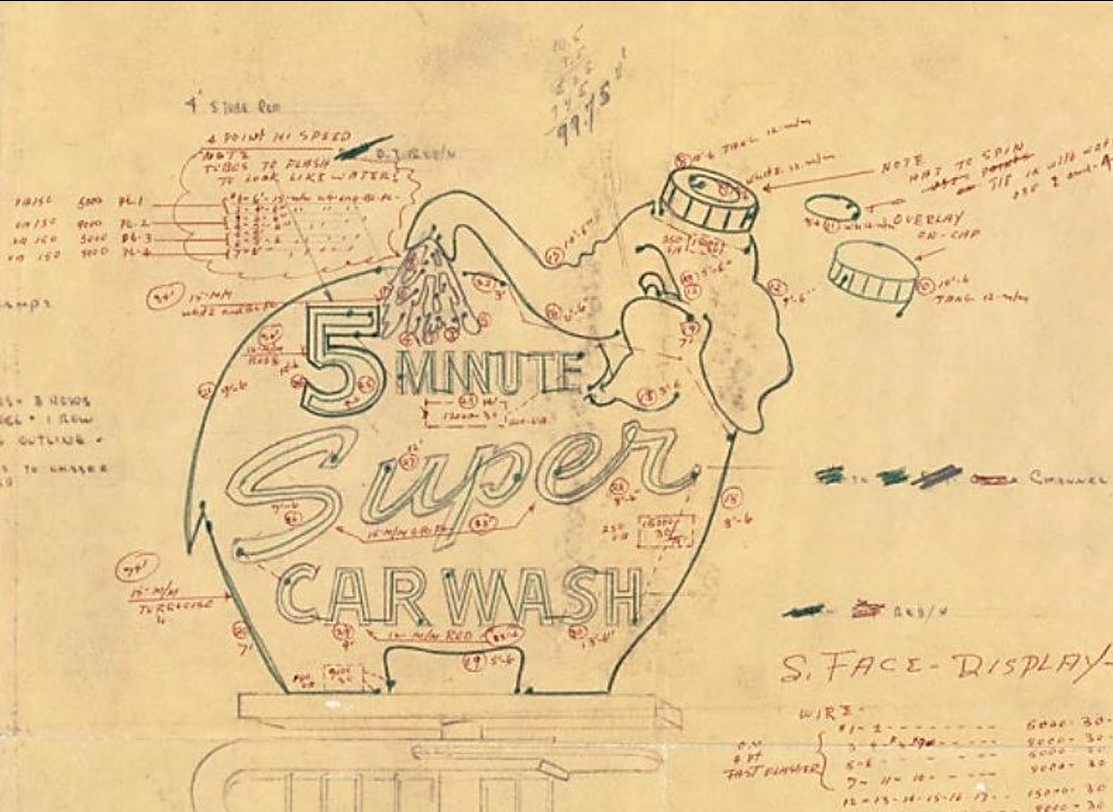

An original sketch of the second Elephant Car Wash sign, shown alongside a photo of the final design (courtesy of Kathleen Wolff). Bea’s daughter, Kathleen—an avid neon enthusiast—rediscovered these drawings in her family’s basement. Today, Bea Haverfield’s luminous legacy is celebrated at the Edmonds Historical Museum.
1956-1960
Patents & Car Wash
Progress In Wash Mechanics
With Elephant Car Wash thriving and their hands-free tunnel wash earning widespread attention, Eldon Anderson focused on securing the innovations that had set their business apart. The mid-to-late 1950s marked a major leap forward in both automation and recognition for the technology he and his brother Dean had developed.
In 1956, Eldon was awarded U.S. Patent No. 2,949,678 for a “vehicle drier nozzle with a self-positioning mount.” This invention dramatically improved the drying process by allowing the dryer nozzle to pivot and adjust to the contours of various vehicle shapes—minimizing the need for manual oversight and maximizing consistency. It was a key advancement in moving toward a fully automated wash system.
Then, in 1960, he received U.S. Patent No. 2,924,389 for a “car-wash conveyor” system—a refined version of his earlier guiding device first filed in 1958. This mechanism helped properly align and guide tires of different sizes onto a moving conveyor belt, preventing misalignment and improving both safety and operational flow. It remains a foundational piece of technology in modern tunnel car washes.
Together, these patents marked the culmination of years of mechanical problem-solving. Eldon and Dean had already been credited with creating one of the world’s first truly automated, no-touch car wash tunnels, which replaced manual scrubbing and soaping with motorized pulleys, overhead sprinklers, directional nozzles, and high-powered dryers.
But with these patents, their contributions were no longer just influential—they were codified as milestones in car wash engineering. And with each innovation, the Elephant Car Wash story became one not just of branding brilliance, but of mechanical ingenuity that helped define an entire industry.

Drawing for one of the patents for automated car wash equipment invented by Eldon Anderson
CHECK OUT THE PATENTS:
1958-1960 Automobile Guiding Device
1956- 1960Vehicle drier nozzle with self positioning mount Vs2
1963
Marketing In Motion:
Big Ideas, Bigger Stunts
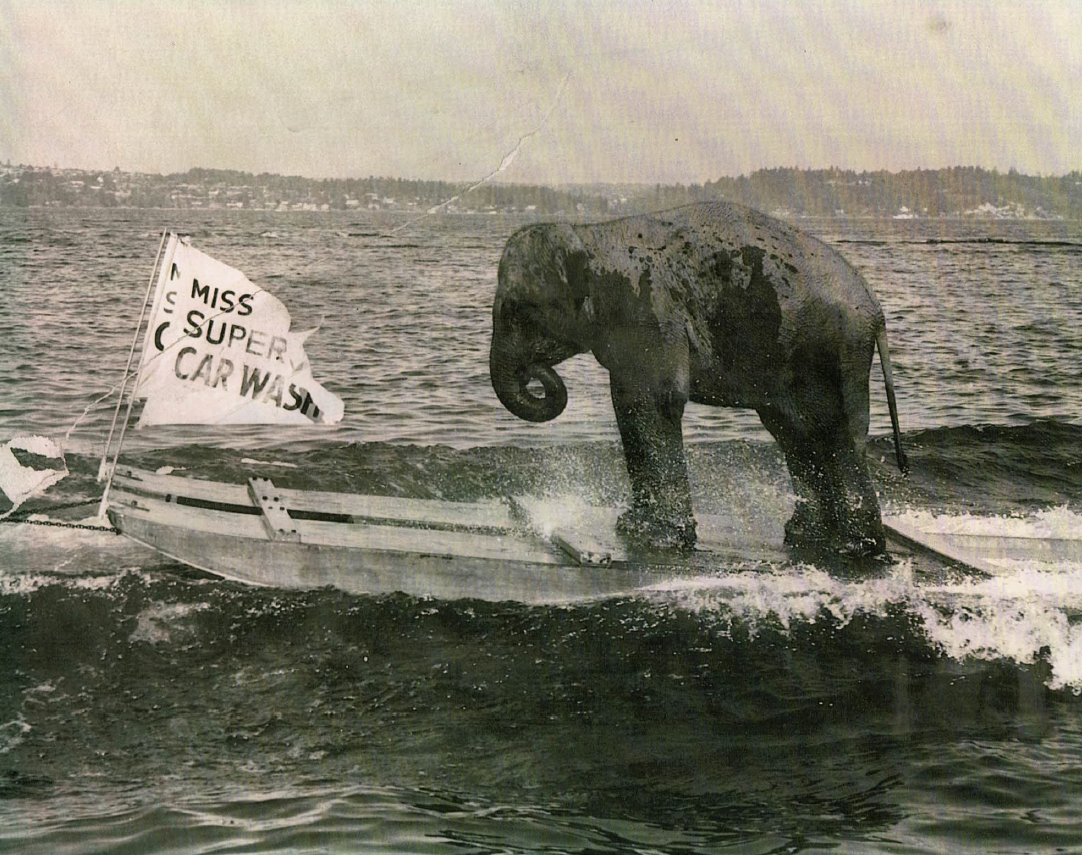
Archie Anderson’s legendary flair for promotion reached new heights when he rigged an elephant on pontoons to stage this unforgettable ‘waterskiing’ stunt—just one of many crowd-pleasing moments during circus season at Elephant Car Wash. Circa 1963
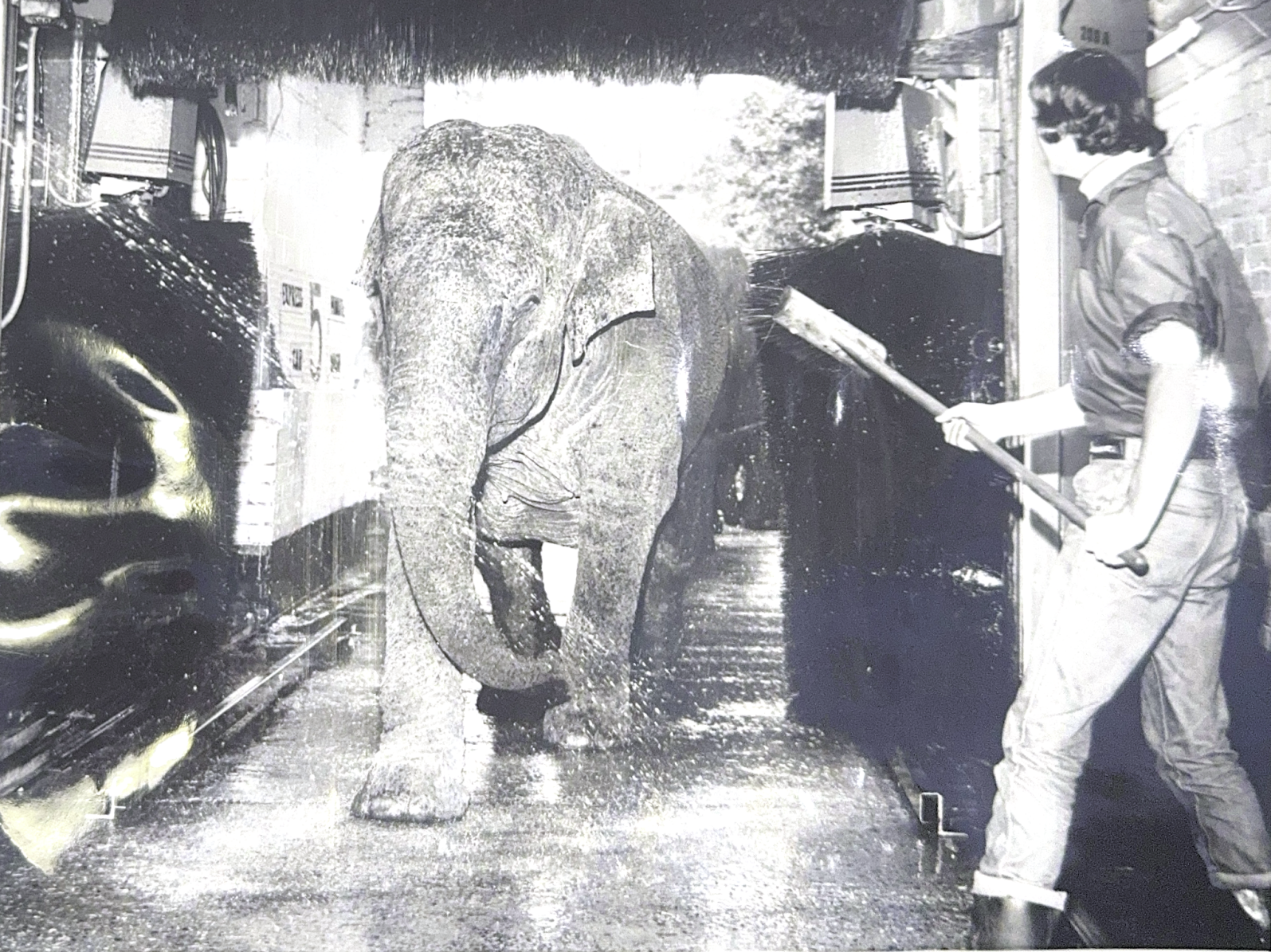
Archie Anderson’s legendary flair for showmanship was on full display during circus season at Elephant Car Wash. In this unforgettable 1963 moment, he hired a real elephant to go through the wash tunnel—delighting crowds and drawing major attention to the brand. With a smiling attendant and suds flying, it was classic Archie: bold, unexpected, and brilliantly on brand.
Archie Anderson’s creativity extended far beyond neon signs—he turned Elephant Car Wash into a stage for unforgettable, crowd-pleasing stunts that brought joy to Seattle and defined the brand’s larger-than-life personality. A natural showman with an eye for spectacle, Archie brought flair and fun to the business, making the car wash as much a local attraction as it was a place to get your car cleaned. His most famous promotion? Inviting real circus elephants to march right through the wash tunnel.
One iconic photo from around 1963 captures a towering elephant mid-scrub, walking between the brushes with soap cascading around it, while a smiling attendant follows alongside with a wash brush in hand. Crowds gathered to watch, and local media happily covered the playful antics, further fueling the pink elephant’s growing fame. Not stopping there, Archie rigged up one of the elephants onto pontoons to create the illusion it was waterskiing—a stunt that perfectly captured the whimsy and charm of the Elephant Car Wash experience. He understood that great branding was about more than a good product—it was about a memorable moment, a story people would share. By then, the brand was more than a clever name and a pink neon sign—it was a Seattle institution, a beloved slice of Americana built on bold ideas, family teamwork, and the kind of imaginative branding that turns small businesses into legends.
1963-1965
Growth & Glamour
And a $50k Glow-Up
As the 1960s unfolded, the Anderson brothers were enjoying the momentum of their rapidly expanding Elephant Car Wash empire. In 1963, they added a third location on Pacific Avenue South in Tacoma, marking their transition from a local family business to a full-fledged regional car wash chain. Their signature blend of innovation and showmanship was working—the Elephant name, paired with its unforgettable pink neon mascot, had become just as iconic as the technology powering each wash.
By 1967, their flagship site at Denny Way and 6th Avenue underwent a bold $50,000 remodel. The brothers hired architect Milton Strickler to modernize the space with sleek, mid-century elements: a covered walkway for comfort, an enlarged vacuum room for convenience, and a contemporary waiting lounge for style. Alongside the facelift came a full upgrade of the wash tunnel’s mechanical systems, keeping Elephant Car Wash at the leading edge of automation and customer experience.

Workers clean a car beneath the iconic Elephant Super Car Wash sign in Seattle, 1965—while the Space Needle stands tall in the background, capturing a classic moment of mid-century city life.
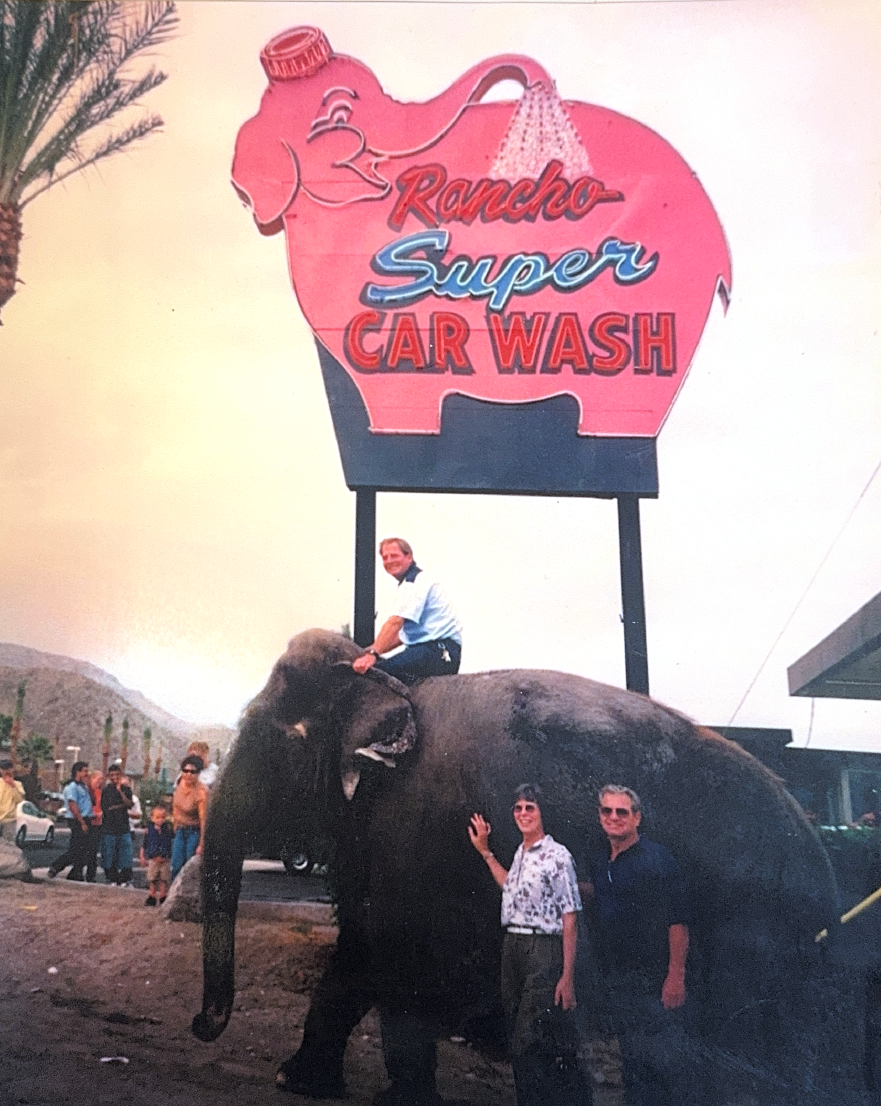
In 2002, the City of Rancho Mirage Historic Resources Survey officially recognized the sign as a rare and significant example of mid-century neon design, reflecting the era’s independent, roadside charm. Today, the elephant still stands proudly on Highway 111—a joyful reminder of classic Americana, the ingenuity of the Anderson family, and a time when neon signs and family-run businesses shaped the spirit of the open road
1966
Elephants
In The Desert
By the mid-1960s, the Elephant Car Wash brand was expanding far beyond the rainy streets of Seattle. In 1965, Richard Fromme and his wife Marilyn—daughter of Eldon and Virginia Anderson—moved to Rancho Mirage, California, bringing the iconic pink elephant with them. A year later, they opened the Rancho Super Car Wash, reassembling a massive neon elephant sign originally built for a Portland wash. The sign was so large, its head had to poke out the top of their moving truck on the drive south. Once installed by Chief Sign Crafts, the cheerful pink pachyderm quickly became a standout along Highway 111, capturing the hearts of locals and tourists alike.
The Rancho location was a runaway success. By 1967, Fromme had become a director of the Rancho Mirage Chamber of Commerce, and the following year, he received a Civic Award for his contributions to the community's charm and character. Business boomed, and in 1973, a second Pink Elephant Car Wash opened at the corner of Frank Sinatra Drive and Highway 111, cementing the elephant's place in the desert landscape. In 2002, the city officially recognized the original sign as a historic mid-century treasure—a glowing testament to the Anderson family’s playful vision and bold branding that proved irresistible from Seattle to the Southwest.
1969
In Glowing Defense
Too Bright To Fail
While the pink elephant was basking in the California sun at its new Rancho Mirage location, back in Seattle, not everyone was glowing with praise. By 1969, the rotating neon sign at the original Elephant Super Car Wash had become a familiar fixture in the city’s skyline—beloved by many, but not by all. That year, a Seattle Times columnist took a jab at what he considered a blight of garish signage across the city. His satirical proposal? Host “sign parties” where people could pay to demolish the worst offenders. On his demolition wish list? A flashy Buick dealership marquee, the “Dodge Fever” ad—and the now-iconic pink elephant.
But what the columnist dismissed as kitsch, the city had come to embrace as character. Far from being an eyesore, the Elephant sign had earned its place in Seattle’s collective memory. It was a glowing emblem of postwar optimism, small business ingenuity, and bold design. Families took photos in front of it. Tourists made it a must-see stop. Locals smiled each time it lit up the rainy skyline.
The elephant endured—bright, bold, and unapologetically pink. And as decades passed, it transformed from controversial neon to cherished landmark, a lasting symbol of Seattle’s playful soul and the power of a strong brand to stand the test of time.

Once called an eyesore, our pink elephant shined through the shade—now a beloved Seattle landmark with a glow that outlasted the critics as beloved part of car wash and neon history.
1982
A New Family
Joins The Herd
In 1982, after more than three decades of building one of the most iconic car wash brands in the country, the Anderson brothers passed the torch—selling all three Washington Elephant Car Wash locations, including the flagship sites on Denny Way and 4th Avenue South, to Bob and Charlotte Haney. Along with the properties, the Haneys also acquired the Elephant Car Wash name and trademark, cementing their role as the new stewards of the pink pachyderm legacy.
Bob Haney brought the same grit and hands-on determination that had defined the Anderson era. Raised in Yakima, Washington, Bob spent his early years juggling long shifts at a Weyerhaeuser mill by day while managing his own mill at night. In the 1970s, he and Charlotte returned to Yakima to open a lumber yard. When the market collapsed, Bob didn’t hesitate—he pivoted, launching a shake and shingle mill in Buckley. But even that venture, like the fading timber industry around it, proved unsustainable.
Then came a brighter opportunity—bathed in pink neon. Selling off their inventory and trading wood for water, the Haneys dove headfirst into the car wash world. They brought with them a tireless work ethic, a knack for reinvention, and a deep belief in building something lasting. With new energy and vision, they revitalized Elephant Car Wash and began writing its next chapter.
Under Bob’s leadership, the brand expanded its footprint across the Puget Sound, with new locations opening in Auburn, Burien, Federal Way, Maple Valley, and Redondo. The 1980s brought economic challenges and new competition, including free gas station washes and do-it-yourself bays. But Bob saw opportunity where others saw risk. He leaned into innovation, modernized operations, and doubled down on customer experience.
Thanks to the Haneys, the neon didn’t just stay lit—it blazed even brighter, ensuring the Elephant remained not only a Seattle icon, but a regional favorite with staying power.
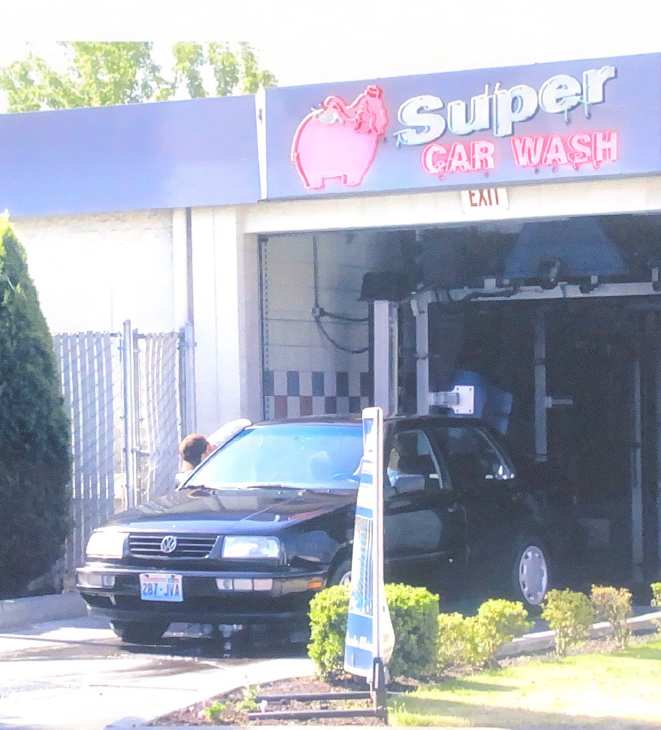
In response to growing public concern over air pollution, the auto industry began overhauling its clearcoat and vehicle paint applications to meet emission standards. While better for the environment, this shift posed big challenges for the car wash industry, as traditional equipment risked damaging the new finishes.
1990
A Softer Shine
By the 1990s, Bob and Charlotte Haney were facing more than just rising competition—they were up against a fundamental shift in car manufacturing. For decades, car washes had relied on windmill-style friction systems that acted almost like buffing wheels. These rotating brushes didn’t just clean; they polished. Older cars painted with single-stage lacquer or enamel held up beautifully, with each wash restoring their shine by stripping away oxidized layers without a scratch. But that all changed in the '90s (with the automotive industry fully transitioned by 1994). In response to tightening environmental regulations aimed at reducing harmful VOC emissions, automakers began transitioning from durable, single-layer finishes to basecoat/clearcoat systems using softer, water-based clear coats. While better for the planet, these new paints were far more vulnerable to micro-scratches—especially from traditional materials used in friction-based wash systems.
Suddenly, car washes weren’t seen as safe polishers—they were seen as threats to pristine paint jobs. But Bob Haney had already seen what happens to businesses that don’t evolve. Drawing on a lifetime of adapting to market shifts, he took swift action. He phased out older brush systems and upgraded Elephant Car Wash tunnels with soft-touch innovations: closed-cell foam and neoprene materials that were gentle on even the most delicate new finishes. Thanks to Bob’s foresight and commitment to innovation, Elephant Car Wash protected its reputation and gave customers peace of mind. At a time when others were scrambling to catch up, Elephant stayed a step ahead—proving once again that great car washes, like great leaders, shine brightest when the pressure’s on.
By the mid 90s, Seattle's Elephant Car Wash was more than just a place to clean your car—it was a cultural icon. Our pink elephant sign became one of the city's most photographed landmarks and appeared in various media, including a 1995 Land Rover commercial, cartoons, and fine art. The cheerful elephant spraying itself with water captured the imagination of many and spread our quirky charm nationwide using various media channels.
1995
Elephant In Media
In the 1990s, Seattle's Elephant Car Wash evolved from a local car cleaning service into a cultural icon, emblematic of the city's quirky charm and innovation. Under the stewardship of Bob and Charlotte Haney, the business expanded beyond its original offerings, integrating gas stations and convenience stores to create a comprehensive, one-stop experience for customers. While the Haney's built strategic product growth, their elephant extended the reach of their business across the USA, making it a familiar sight in movies, cartoons, and art.
The distinctive design of the pink elephant, with its playful imagery of a self-spraying trunk, captured the imagination of artists and advertisers alike. It inspired various forms of art, including enamel pins and oil paintings, and was featured in a 1995 Land Rover commercial, showcasing its status as a recognizable landmark and its appeal as a symbol of adventure and reliability. As the years progressed, while some Elephant Car Wash locations closed, efforts were made to preserve its legacy. The original pink elephant sign was donated to Seattle's Museum of History and Industry (MOHAI), ensuring that this piece of the city's history would continue to be celebrated. Today, the Elephant Car Wash remains a beloved emblem of Seattle's past, a testament to the city's embrace of the whimsical and the iconic. Its enduring presence in art, media, and public memory underscores its significance as more than just a car wash—it is a cultural touchstone that continues to inspire and delight.
2010-2015
Going Touchless
A New Era in Clean
In 2010, Elephant Car Wash took another bold leap forward by opening its first fully touchless automatic wash in Auburn, Washington. As automotive finishes evolved (transitioning to softer, more eco-friendly clear coats), traditional friction-based systems risked scratching modern vehicles. The shift rocked the car wash industry, but it also sparked a wave of innovation.
Elephant responded with confidence and care, launching a system that used high-pressure water jets and specialized detergents to deliver a powerful, contact-free clean—no brushes, no friction. Once it proved effective at removing the tough Washington dirt and grime, the touchless model became a welcome addition to the Elephant lineup.
The system was a hit, especially with drivers who cherished their vehicles and already trusted the Elephant Car Wash name. By offering this next-generation wash option, Elephant stayed ahead of the curve—providing more choices, better protection, and the same commitment to quality, care and innovation that made it a Seattle icon.

One of the original touchless car washes at Elephant Car Wash. This High Velocity touchless systems—an early step into the future of car washing—was a huge deal at the time! We’ve upgraded since then, but the legacy lives on as we've installed newer and more powerful models of touchless car washes in Washington and Arizona.
2020
A Farewell
To The Original Elephant
In 2020, after 64 years of service, the original Elephant Car Wash at Denny Way and 6th Avenue closed its doors. Once a bustling symbol of Seattle’s postwar boom, the landmark faced mounting challenges—rising costs, construction congestion, safety concerns, and regulatory strain—all contributing to the decision to shut down.
Still, the spirit of the pink elephant lives on. The larger rotating neon sign, a beloved and highly photographed piece of Seattle history, was donated to the Museum of History & Industry (MOHAI) in South Lake Union. The smaller elephant sign was gifted to Amazon, which pledged to restore and display it on their nearby campus as a tribute to the neighborhood’s past. Though the wash itself is gone, the signs remain—thanks in part to preservation efforts that highlighted their cultural significance and helped secure funding for their restoration. Today, the pink elephant continues to shine as a glowing reminder of Seattle’s roadside charm, innovation and identity.
2023
Arizona Expansion:
A New Frontier for the Elephant
By 2023, Elephant Car Wash made a bold leap beyond its Pacific Northwest roots—expanding operations into Arizona with new locations in Glendale and Peoria. This marked an exciting new chapter for the brand, introducing the beloved pink elephant, cutting-edge wash technology, and decades of family-driven car care to the desert Southwest. It wasn’t just about growth—it was about legacy. Leading the charge were Bob Haney’s grandchildren, the third generation of neon torchbearers, bringing fresh energy and vision while staying true to the brand’s iconic charm.
The expansion to Arizona added a new frontier to a story that already spanned from Washington to California. In Rancho Mirage, California, the Elephant Car Wash sign had long stood as a gleaming tribute to the brand’s flair for design and roadside appeal. Officially recognized in 2002 by the City of Rancho Mirage Historic Resources Survey, the sign was hailed as a rare and significant example of mid-century neon art—reflecting an era when bold design and family-run businesses defined the American road trip experience. Even today, the pink elephant still smiles from its post along Highway 111, a joyful reminder of classic Americana and the Anderson family's ingenuity.
With roots firmly planted in Washington and California, and now reaching into the Sonoran sun, Elephant Car Wash continues to evolve—bringing its signature sparkle to new communities while preserving the spirit that made it a roadside icon. From neon nights in Seattle to bright desert days in Arizona, the elephant marches on, proudly guided by the next generation.

In 2002, the City of Rancho Mirage officially recognized the Rancho Super Car Wash sign as a rare and significant example of mid-century neon design, reflecting the era’s independent, roadside charm. Today, the iconic pink elephant still stands proudly on Highway 111—a joyful reminder of classic Americana and the ingenuity of the Anderson family. However, it's important to note that the Elephant Car Wash in Rancho Mirage, CA, operates independently and is not affiliated with any other Elephant Car Wash locations outside California.
2026
Continuing the Legacy:
Celebrating 75 Years!
As Elephant Car Wash approaches its 75th anniversary, the brand’s legacy shines brighter than ever. What began in 1951 as a family-run experiment in innovation has grown into a beloved regional icon and an enduring symbol of Seattle’s spirit. Through decades of technological advancement, whimsical branding, and family stewardship—from the Anderson brothers to the Haney family—Elephant Car Wash has never lost sight of its roots: quality, creativity and community.
Now under the care of a new generation, the neon torch continues to be passed. The elephant still stands proudly across the Puget Sound region, serving customers with modern wash systems while honoring the nostalgic charm that made it famous. With 75 years behind it and a future full of opportunity, Elephant Car Wash remains a glowing tribute to American ingenuity and roadside Americana—one wash at a time.

Now under the care of a new generation, the pink neon elephant torch continues to be passed. The elephant still stands proudly across the Washington and Arizona.


